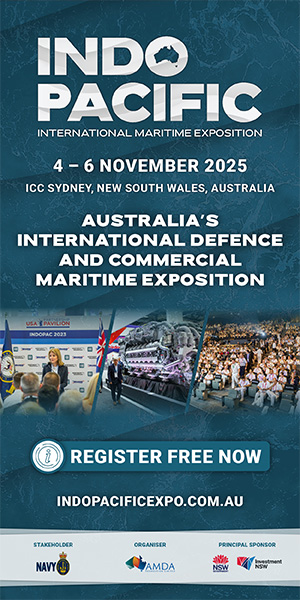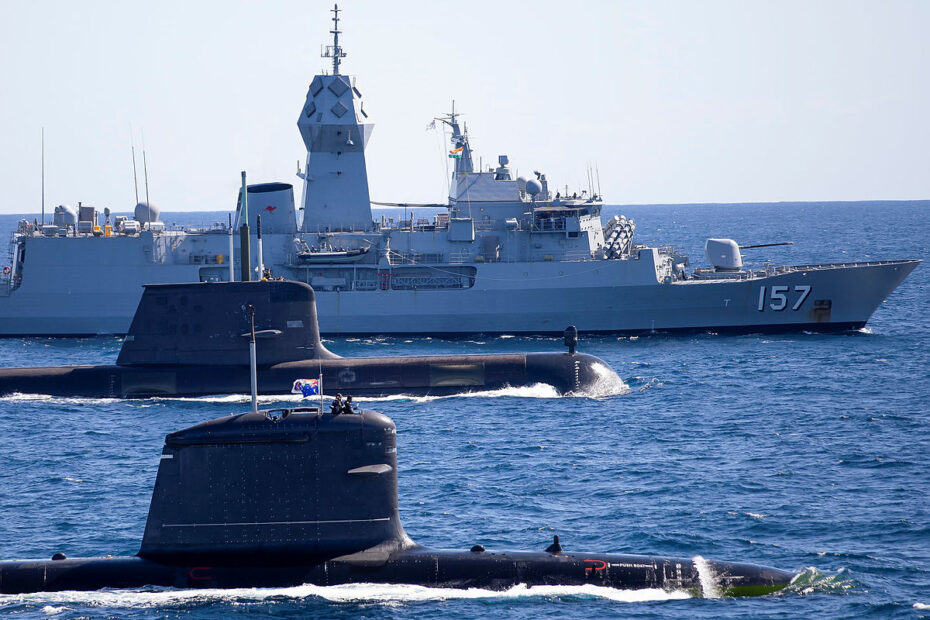Indian Submarine INS Vagir, Australia’s submarine HMAS Rankin and Australian warship HMAS Perth conduct maneuvers exercise at Fleet Base West in Perth (Photo Credit: Australian Department of Defence)
In the ever-evolving landscape of global security, a significant and unprecedented shift is underway in the naval domain, particularly beneath the ocean’s surface. Projections indicate that by the year 2030, the world will be home to approximately 600 submarines, with a staggering half of them prowling the strategic waters of the Indo-Pacific region. The question that naturally arises is: Why is there such a substantial concentration of submarines in this vast maritime expanse, and what does this surge signify for geopolitical dynamics?
Submarine proliferation in the Indo-Pacific
The Indo-Pacific region, stretching across the Indian and Pacific Oceans, has emerged as a focal point for naval competition and strategic posturing among major powers. The significant increase in submarine numbers within this theater is driven by a combination of geopolitical, economic, and security considerations.
1. Geopolitical rivalries
The Indo-Pacific is witnessing intensified geopolitical rivalries, particularly between major players like the United States, China, and regional powers. Submarines, being stealthy and strategically elusive, provide a critical edge in power projection and deterrence.
2. Economic interests
Given the economic significance of sea lines of communication (SLOCs) in the Indo-Pacific, nations are keen on safeguarding their maritime interests. Submarines serve as formidable tools to protect vital trade routes and critical infrastructure.
3. Strategic encirclement
Nations are employing submarines as part of broader strategies for regional influence. Submarine fleets offer a means of strategic encirclement, enhancing a country’s ability to control and dominate maritime spaces.
4. Undersea nuclear deterrence
The Indo-Pacific is witnessing the expansion of nuclear-armed submarines. Nations with these capabilities seek to establish credible nuclear deterrence, adding a layer of complexity to regional security dynamics.
The Technological Evolution
The surge in submarine numbers is not solely about quantity but also about advancements in technology. Modern submarines are equipped with sophisticated systems, including artificial intelligence, quantum technology, and electronic warfare capabilities. These technological upgrades enhance stealth, intelligence gathering, and the ability to operate in contested environments.
AUKUS, Quad and Indo-Pacific
The recently formed AUKUS alliance (Australia, the United Kingdom, and the United States) has further fueled the submarine proliferation in the Indo-Pacific. AUKUS aims to bolster the naval capabilities of its member nations, with a specific focus on nuclear-powered submarines. This collaborative effort is a response to the evolving security challenges in the region, particularly posed by China. The Quad partners (US, Australia, Japan, India) also see China’s advancements in the Indo-Pacific as a threat to regional stability and peace.
China’s growing underwater arsenal
China’s rapid naval expansion, including its submarine fleet, plays a pivotal role in shaping the Indo-Pacific submarine landscape. The Chinese navy has been investing heavily in both conventional and nuclear submarines, seeking to establish maritime dominance and safeguard its expanding interests.
Implications for Regional Stability
In conclusion, the Indo-Pacific’s submarine surge is a testament to the region’s strategic importance and the evolving dynamics of naval warfare. As nations invest in advanced submarine capabilities, the underwater realm becomes a critical theater for competition and cooperation, with implications that extend far beyond the ocean’s depths. The coming decade will undoubtedly witness the outcomes of this subterranean shift, shaping the geopolitical landscape of the Indo-Pacific in ways that demand careful observation and strategic foresight.





